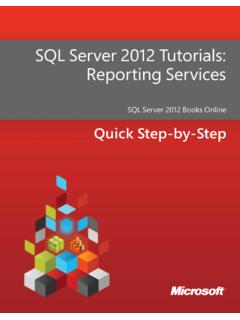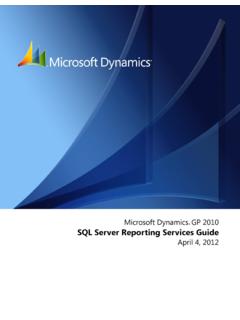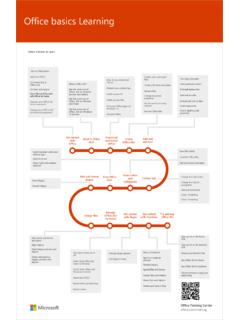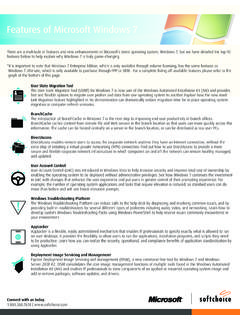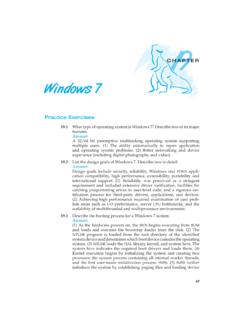Transcription of Upgrading from Windows XP to Windows 7
1 Upgrading from Windows XP to Windows 7. Upgrading your PC from Windows XP to Windows 7 requires a custom installation which doesn't preserve your programs, files, or settings. It's sometimes called a clean installation for that reason. A custom installation is more complex, and it can sometimes take a couple of hours to complete. We created this five-step tutorial to help guide you through the entire process each step of the way. What you 2. 32-bit or 64-bit: Which version of Windows 7 to install? .. 2. Step 1: Download and run Windows 7 Upgrade Advisor .. 2. Download and install Windows 7 Upgrade 3. Run Windows 7 Upgrade Advisor .. 3. Step 2: Moving files and settings, and gathering your program discs .. 4. Download and install Windows Easy Transfer .. 5. Run Windows Easy Transfer to save your files and settings.
2 5. Gather your program discs and setup files .. 6. Step 3: Installing Windows 7 .. 6. Before you begin .. 7. Perform a Custom installation of Windows 7 .. 7. Troubleshooting installation problems .. 7. Step 4: Moving your files and settings back to your computer .. 8. Move files and settings back using Windows Easy Transfer .. 9. Step 5: Reinstall your programs and update drivers .. 10. Update drivers .. 11. Netbooks and drivers .. 12. Post-install clean-up (optional) .. 12. Upgrading from Windows XP to Windows 7. What you need An external hard disk. You'll need to move your files off of your PC before you install Windows 7. To make this easier, we recommend a free download called Windows Easy Transfer, which will require an external hard disk. They're readily available at electronics and office supply stores, and they provide an easy way to add additional storage space to your computer.
3 The original installation discs or setup files for the programs that you want to use with Windows 7. You'll need to reinstall your programs by hand after installing Windows 7. When you run Windows Easy Transfer you will get a report that lists the programs that you are currently using with Windows XP. Overview of the process for Upgrading from Windows XP to Windows 7. 32-bit or 64-bit: Which version of Windows 7 to install? Both 32-bit and 64-bit installation discs are included in the Windows 7 package. 64-bit operating systems can handle large amounts of memory typically 4 gigabytes (GB) of random access memory (RAM) or more more efficiently than 32-bit operating systems. However, not all computers are 64-bit capable. You'll probably need the 32-bit version, but to make sure click Start, right-click My Computer, and then click Properties.
4 If you don't see "x64 Edition" listed, then you're running the 32-bit version of Windows XP. Step 1. of this tutorial will show you how to run Windows 7 Upgrade Advisor, which can let you know if your computer is capable of running the 64-bit version of Windows 7. If "x64 Edition" is listed under System, you're running the 64-bit version of Windows XP and can run the 64-bit version of Windows 7. Step 1: Download and run Windows 7 Upgrade Advisor To find any potential issues with your computer's hardware. devices. or programs that might affect installing Windows 7, download and run the free Windows 7 Upgrade Advisor. It provides a report listing any issues that it finds and gives recommendations on what to do. Page | 2. 2009 Microsoft Corporation. All rights reserved. Upgrading from Windows XP to Windows 7.
5 A report lists any actions needed to prepare your computer for Windows 7. Download and install Windows 7 Upgrade Advisor Follow the steps below to download the Windows 7 Upgrade Advisor. 1. Go to the Windows 7 Upgrade Advisor ( ). webpage. 2. Click Download the Windows 7 Upgrade Advisor. 3. Click Download, and then save the installation file to your computer. 4. Double-click the installation file. If you're asked to install .NET Windows 7 Upgrade Advisor requires .NET Framework If your computer doesn't have it installed, follow these steps. If you're not asked to install .NET , you can skip this and proceed to step 5. 1. Click Yes. 2. Click Next. 3. If you agree to the license terms, click Install. 4. Click Finish. 5. If you agree to the license terms, click Install. 6. Click Close. If you see a pre-selected check box, clicking Close will open Windows 7 Upgrade Advisor.
6 Run Windows 7 Upgrade Advisor 1. If Windows 7 Upgrade Advisor isn't already running, double-click the Windows 7 Upgrade Advisor shortcut on your desktop. Page | 3. 2009 Microsoft Corporation. All rights reserved. Upgrading from Windows XP to Windows 7. 2. In the security warning dialog box, click Yes. 3. Click Start check. 4. Read the report carefully, and make note of any issues that the Upgrade Advisor finds and what the recommended steps are to fixing these issues. 5. If you want to save the report and print it later, click Save Report, type a name in the File Name box, and then click Save. 6. Click Close. Step 2: Moving files and settings, and gathering your program discs Windows Easy Transfer is a free download that can help you move your files and settings to another location before you install Windows 7, and then back to your PC after Windows installation is completed.
7 Windows Easy Transfer helps simplify moving your files and settings. Windows Easy Transfer creates a single file containing your files and settings. The file could be quite large depending on the amount of data you have, which is why we recommend using an external hard disk. As you prepare to move your files off of your computer to an external storage device, remember the following: Page | 4. 2009 Microsoft Corporation. All rights reserved. Upgrading from Windows XP to Windows 7. Windows Easy Transfer doesn't move your programs, only your files and settings. You'll need to reinstall your programs by hand after Windows 7 installation is complete. Windows Easy Transfer will provide you with a list of programs that you are currently using with Windows XP. Windows Easy Transfer can't transfer files from a 64-bit version of Windows to a 32-bit version of Windows .
8 This means if you're running a 64-bit version of Windows XP, but you plan to install a 32-bit version of Windows 7, you won't be able to use Windows Easy Transfer to migrate your files and settings. You'll also need Windows XP Service Pack 2 or higher. If you're not sure of what you have, click Start, right-click My Computer, and then click Properties. Under System, if you see "Service Pack 2" or "Service Pack 3", you can use Windows Easy Transfer. If you're not running Service Pack 2 or 3, go to the Windows XP service pack ( ) webpage to update your PC. Download and install Windows Easy Transfer 1. Download Windows Easy Transfer ( ) from the Windows website. If you're running a 32-bit version of Windows XP, under For Windows XP:, click Download 32-bit. If you're running a 64-bit version of Windows XP, click Download 64-bit.
9 2. Click Download, and then click Open. Run Windows Easy Transfer to save your files and settings 1. Make sure your external hard disk or other storage device is connected to your computer. 2. Click Start, click All Programs, and then click Windows Easy Transfer for Windows 7. 3. Click Next. 4. Select An external hard disk or USB flash drive. 5. Click This is my old computer, and then wait while Windows Easy Transfer scans the computer. 6. Clear the check boxes next to any user accounts that you don't want to transfer data from, and then click Next. 7. Enter and retype a password, and then write it down and keep it in a safe place; or leave the boxes blank, and then click Save. 8. Browse to the external hard disk or other storage device where you want to save your Easy Transfer file, and then click Save.
10 Warning You must save the Easy Transfer file to your external hard disk or other storage device, and not to the default location My Computer. If you don't save the Easy Transfer file to your external hard disk, the file you just created will be deleted during the custom installation of Windows 7. 9. Windows Easy Transfer will begin saving your files and settings. Do not use your computer during this time. Page | 5. 2009 Microsoft Corporation. All rights reserved. Upgrading from Windows XP to Windows 7. 10. When you see the message These files and settings have been saved for your transfer, click Next. Windows Easy Transfer displays the file name and location of the Easy Transfer file you just created. Write down the file name and location so you can easily find it when you're ready to transfer files to Windows 7.



